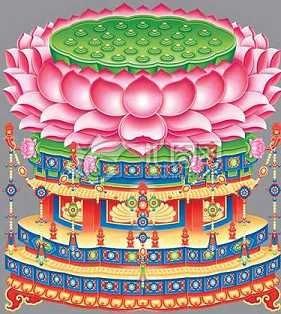调入气中
发布时间:2023-02-24 16:02:52作者:心经原文网调入气中
[作者]坦尼沙罗尊者

[中译]良稹
Tuning-in to the Breath
by Ven. Thanissaro Bhikkhu
When I first went to stay with Ajaan Fuang, one of the questions I asked him was, “What do you need to believe in order to meditate?” He answered that there was only one thing: the principle of kamma. Now when we hear the word “kamma,” we usually think, “kamma-and-rebirth,” but he meant specifically the principle of action: that what you do shapes your experience.我跟随阿姜放之初,曾经问过的一个问题是:“为了禅定,需要信什么?”他回答,信一件事: 业的原则。不过我们听见“业”这个词,常常想到的是“业与轮回”,他所特指的却是行动的原则,即: 行为塑造体验。
If you’re convinced of this, you can do the meditation because, after all, the meditation is a doing. You’re not just sitting here, biding your time, waiting for the accident of Awakening to happen. Even in very still states of meditation, there’s an activity going on. Even the act of “being the knowing” is still a doing. It’s a fabrication, a sankhara. In one of the suttas, the Buddha says that all the different khandhas, all the different aggregates that make up experience as a whole, have to get shaped into aggregates by the process of fabrication. In other words, there’s a potential for a form, a potential for a feeling, potential for perception, fabrication, consciousness; and the act of fabricating is what turns these potentials into actual aggregates.如果你确信这一点,就可以作禅定,因为毕竟,禅定是一种作为。你并非仅是坐在这里守候时光,等待觉醒的偶发突现。即使在极其寂止的禅定境界之中,仍然有一种动作进行着。即使“成为觉知”的动作,仍然是一种作。它是一种造作,一种行[sankhara]。在一篇经文当中,佛陀说, 构成整个体验的所有蕴,所有聚集体[khandhas],必须被造作的过程塑造成诸蕴。换句话说,有一种色的潜在可能性,一种受的潜在可能性,有想、行、识的潜在可能性。正是造作的动作,把这些潜在可能性转为实际的诸蕴。
It sounds abstract, but it’s a very important lesson for the meditation even from the very beginning. You sit here in the body—and of course, that’s a fabrication right there: the idea that you’re sitting in the body—but given all the many different things you could focus on right now, there’s the possibility of choice. This possibility of choice is where kamma comes in. You can choose any of the sensations that are coming into your awareness. It’s as if there were a buzz in all the different parts of the body. There’s a potential for pain here, a potential for pleasure over there. All these different sensations are presenting themselves to you for you to do something about them, and you have the choice as to which ones you’ll notice.听起来抽象,但它对禅定来说,甚至从一开始,就是极其重要的一课。你在这里, 坐于身内——当然,那里就有一个造作: 你坐在身内的这个想法——不过,既然有许多东西你现在可以专注,那就有选择的可能性。这个选择的可能性,正是业力因果发生作用的地方。你可以选择来到你觉知范围内的任何觉受。就仿佛体内所有不同的部位都在滋滋作声。这里有痛的潜势,那里有乐的潜势。所有这些不同的觉受都把自己放在你面前,让你对它们做点什么,你将会注意其中的那些,是有选择的。
Doctors have done studies showing that pain isn’t just a physical phenomenon. It isn’t totally a given. There are so many different messages coming into your brain right now that you can’t possibly process them all, so you choose to focus on just some of them. And the mind has a tendency to focus on pain because it’s usually a warning signal. But we don’t have to focus there. In other words, there can be a slight discomfort in a part of the body, and you can focus on it and make it more and more intense, more and more of an issue. That’s one thing you can do right now, but—even if you may not realize it—you have the choice of whether or not to do that. You can choose not to make it more intense. You can choose even to ignore it entirely. Many times we have habitual ways of relating to sensations, and they’re so habitual and so consistent that we think there’s no choice at all. “This is the way things have to be,” we think, but they don’t.医生们做过一些研究显示,痛不仅仅是一种身体现象。它不完全是先决的。当下来到你的大脑中的讯息如此之多,你不可能全部处理,因此你选择只专注其中的一部分。心有专注痛感的倾向,是因为通常它是一种预警讯号。不过,我们并不是非得专注那里。换句话说,可能在身体的某处略微有点不舒适,你可以盯着它,使不舒适感越来越激烈,越来越成问题。那是你当下可以做的一件事,然而——即使你或者没有意识到——做与不做,你是有选择的。你可以选择不令它更激烈。你甚至可以选择彻底漠视它。很多时候,我们对觉受有一些习惯性的反应,它们如此习惯化,如此常规化,我们以为不存在选择。“事情只能这样,”我们这么想,然而,它们并非如此。
That’s the other implication of the principle of kamma: You can change your actions. If some parts of experience are dependent on choice and fabrication, you can choose to change. You see this really clearly when you focus on the breath. The breath is always there in the body, and if you look carefully you’ll discover that it has many levels. It’s like looking up in the sky: Sometimes you feel a breeze coming from the south, but you look up in the sky and see a layer of clouds moving east, and another higher layer of clouds moving west. There are lots of different layers of wind in the atmosphere and, in the same way, there are lots of different layers of breath in the body. You can choose which ones to focus on.那就是业的原则的另一个寓意: 你可以改变你的行为。如果体验的某些部分随选择和造作而定,你可以选择改变。这一点,在你专注气时,可以看得很清楚。气在体内始终存在,如果你仔细观察,就会发现,它有许多层次。就好比观测气象: 有时侯,你察觉一阵轻风从南方吹来,然而抬头观天,看见一个云层在朝东移动,另一个更高的云层在朝西移动。大气层中存在许多层次不同的风,同样地,身体内部存在许多层次不同的气。你专注其中的那些,是可以选择的。
It’s like having a radio receiver: You can choose to tune-in to different stations. The radio waves from all the nearby radio stations, all the different frequencies, are all in the air around us. There are radio waves from Los Angeles, radio waves from San Diego, even short wave radio waves from who-knows-where, all over the place. They’re going through this room right now. They’re going through your body right now. And when you turn on the radio you choose which frequency you want to focus on, which one you want to listen to. The same with the body. You sort out, of all the possible sensations, just one type of sensation to focus on: the breath-ness of the breath. Wherever you feel the sensation of the in-and-out breath most clearly, you focus right there. Now some of us have a radio we haven’t taken very good care of, and as soon as we tune it in to one station it slips over to another. So you’ve got to keep tuning it back, tuning it back.这就像是无线电接收器。你可以选择调收不同的电台。来自附近所有电台的电波,所有不同的频率,都存在于我们周围的空中。有来自洛杉矶的电波、来自圣迭哥的颠簸、甚至有不知哪里来的短波,到处都是。它们现在正在穿过这间屋子。它们现在正在穿过你的身体。当你打开收音机时,你选择想专注的频率,想聆听的频率。身体也同样。你在所有可能的觉受中分捡,单单挑出一类觉受——气的气性——专注于它。你在哪里最清晰地感受到出入息,就把注意力定在那里。我们有些人有一台保养不佳的收音机,一调到某个频率,它就滑到别的频率上。因此,你不许不停地把它往回调、往回调。
But the problem isn’t just the tuning. It’s what you do with the sensation once you’ve tuned-in to it. Again, you can focus on the breath in a way that makes it painful, or you can focus on it in a way that makes it comfortable. You’re not faced just with the given-ness of the breath. What you do with it can make it more or less painful, more or less comfortable. To continue the analogy, it’s like having a volume control on the radio: You can turn it way up loud so that it hurts your ears, or you can turn it way down soft so that you can hardly hear it at all. But as you get more skillful with your volume control, you get a sense of what’s just right so that you can adjust the level and the pressure of your focus for maximum enjoyment.不过,问题还不单单是调频。还有一旦调进去了,对那个觉受做什么的问题。再一次,你专注气的方式,可以令它痛苦,也可以是令它舒适的。你面临的并非仅仅是前定不变的气。你对它做什么,可以使它多痛或少痛、多乐或少乐。延续先前的比喻,就好像收音机上有个强度调纽: 你可以把它调得巨响,以至于耳痛,或者,你可以把它调得极弱,以至于几乎听不见。不过,随着你对强度的调节熟练起来,就会懂得什么是恰到好处,这样就可以调整你专注的层次和力度,获得最大的享受。
As you get tuned-in more and more precisely, you discover there are other subtleties as well. Again, like the radio, when you really get tuned very precisely onto the frequency, the static goes away and you can hear subtleties in the signal that you couldn’t hear before. You can play with them, turn up the treble, turn up the base, whatever you want. So even though the radio signal is a given, you can do a lot with it. That’s the element of kamma in your meditation right now: It’s what you’re doing with the breath.随着你的调入越来越准,你还会发现其它的细节。再一次,以收音机作比方,当你极其准确地调到那个频率上时,杂音消失了,你就可以听见讯号中过去听不见的微妙之处。你可以操纵它们,把高音成分调响,把低音成分调响,随心所欲。因此,尽管那个无线电讯号是先决的,你对它可以有很多作为。那就是你当下禅定当中业的因素: 就是你对那个气做什么。
You can learn how to be more skillful in how you relate to it so that you can sense not only the very obvious breath of the air coming in and out of the lungs, but also the sensations that go through the whole body as you breathe in, as you breathe out, the patterns of movement in the body that actually bring the air into the lungs and let it go out. There’s a wave going through the body each time you breathe. As you become sensitive to it, you begin to sense where there’s tension in the body, and where there’s not; where the subtle breath flows properly, and where it doesn’t.你可以学会以更善巧的方式应对气,使得你可以不仅感觉到极其明显的出入肺部的空气,而且感觉到随着你入息,出息而穿过整个身体的诸种觉受,感觉到体内真正把空气带入肺中、又让它呼出的那些动态分布。每一次你呼吸,都有一阵波动贯穿身体。随着你对它敏感起来,你开始感觉到,身内哪里有张力,哪里没有; 哪里精细的气流动正常,哪里不正常。
And, again, it’s not just a given. You can do things with that flow. You can improve the flow. If you notice tension in a certain part of the body, you relax it; and oftentimes doing this improves the breath flow not only at that one spot but also in other parts of the body as well. You begin to have a sense of the body as a whole series of different interconnected energy patterns. A tightening up here may lead to a tightening up over there, and it all gets connected in a feeling of overall constriction, of bands of tension squeezing the body. Or you can loosen it up. That’s your choice. You can relax this bit of tension here and find that it leads to an unraveling of tension over there. Or you might find that everything gets so loose that you drift off. This means that you’ve got to learn how to gain a sense of “just right” so that you can stay with the sensation, keep your focus, and even if the radio signal begins to drift a little bit, you can follow it precisely and stay right with it.再一次,它不是先决的。对那股气流,你可以有所作为。你可以改善它。如果你注意到体内某个部位存在张力,就放松它; 这样做,往往不仅改善了那一个部位的气流,而且也改善了其它部位的气流。你开始把身体理解成一大堆不同的、相互连接的能量分布系列。这里的某个紧绷,可能会导致那里的紧绷,这一切都被系结起来,成为一股总体的紧压感,成为挤抑身体的一条条紧勒感。或者,你也可以把它们松开。那是你的选择。你可以放松这里的一点张力,发现它导致了那里张力的解开。或者,你可能发现,一切变得如此松弛,你游移而去。这说明,你必须学会一种“恰到好处感”,使得你可以长住那种觉受,维持你的专注,即使那个无线电讯号开始稍有移动,你可以准确地跟着它,不懈地随着它。
At this point you can let go of the sensation of the in-and-out breath—the coarse breath, the obvious breath—and focus more on the subtle breath flow in the body. As you work through all the different parts of the body where it feels tense or blocked or sort of squeezed out, you let the breath sensations fill all those little nooks and crannies, and there comes a greater and greater sense of fullness, refreshment. That’s what piti means. It’s the drinking-in of the good sensation. We normally translate piti as rapture, but it’s also related to the word for drinking, pivati. You drink-in this nice sensation. It feels full, it feels refreshing all the way through the body because you’ve opened up all the little cells in the body and allowed the breth to enter. When you get that sense of fullness, it’s easier to relax.这个时候,你可以放开出入呼吸之感——也就是粗糙的气感、明显的气感——把注意力更多地放在体内精细的气流上.随着你对体内所有那些感受到张力、阻碍、或外挤的部位加以彻底耕作,你让气感充满所有那些细小的角落,一股越来越大的充沛感、清新感就会出现。那就是喜的意思。它是良好觉受的饮入。我们一般把 piti 翻译成 rapture——喜,然而与它相关的还有另一个词,pivati——啜饮。你饮入这股良好的感觉。整个身体感到充沛,感到清新,因为你已经开启了体内所有的细孔,让气入内。当你得到那种充沛感时,放松就比较容易了。
This may not be a pretty image, but the mind at this point is like a mosquito when it’s finally hit a big vein in your body. It sticks its little proboscis in and just stays right there, bathed in bliss. Its wings go weak, its feet go weak, and no matter how much you try to brush it away, it just doesn’t want to go. It’s just drinking-in what it wants. The same with the mind: As soon as that refreshing breath sensation begins to fill the body, you let go of everything else. No matter what other disturbances come, you’re not the least bit interested because you’ve got something really satisfying. You could almost say that it’s a sensation to die for. You let down your guard, let go of everything else, because this sensation is so totally absorbing. You’ve opened up every part of the body, every part of your awareness for this sensation to come in.下面这个比喻,形象也许不甚美观,不过这时候的心,就像一只终于找到你体内一根大静脉的蚊子。它把小小的长吻伸了进去,就在那里呆着不动,沐浴在极乐之中。它的翅膀失去力量,它的细足失去力量,不管你怎样推它,它就是不想走。它就在饮入它想要的东西。心也同样: 一旦那股清新的气感开始充满身体,你就把一切放开了。无论来了其它什么干扰,你毫无兴趣,因为你已经得到某种令你极其满足的东西。几乎可以说,它是一种可以为之而死的觉受。你放下自己的防护,放开其它一切,因为这种觉受具有如此彻底的吸摄感。你已经开放了身体的每一个部分,你的觉知的每一个部分,让这股觉受入内。
As you stay there and the mind grows more and more still, you become aware of a deeper sensation of absolute fullness with no sense of flowing back and forth—a real stillness in the body. There’s a slight sense of air exchange on the very surface of the body, the surface of your awareness, but deep down inside there’s a great stillness. There’s no longer the sense of drinking-in because you’re absolutely full. Ajaan Lee uses the image of an ice cube: A vapor is coming off the cube—a very vaporous movement around the edge of your awareness—but everything else is solid and still.随着你呆在那里,心越来越寂止,你开始觉察到一种更深的、没有来回流动的绝对充沛之感——体内的一种真正的寂止。在身体的表面,在你的觉知的表面,有一股微微的换气感,但内部深处,是巨大的寂止。饮入感不复存在,因为你已经绝对充满。阿姜李用冰块的形象作比喻: 一股水汽从冰块上冒出——也就是,在你的觉知边缘附近,有一种极其雾状的动态——然而其它的一切坚固、寂止。
And then finally even that vapor stops, and the solidity fills your whole awareness. It’s accompanied by a sense of brightness, even though you may not sense this brightness as a light. It’s a peculiar quality: a physical sensation, a feeling tone, of brightness, clarity, filling the whole body, and you’re just sitting there in the middle of it.接下来,到最后,连水汽也停止了,那股固性充满了你的整个觉知。伴随着的,是一股明亮感,尽管你也许不觉得这种明亮像一盏灯。它是一种奇特的素质: 明亮、清晰、充满全身的一种身体感,一种觉受基调,你只是坐在那里,在它的中间。
There’s no need to rush through these stages, no need to go jumping through hoops. In fact, it’s best if you not try to rush. Just find one sensation you can tune-in to. Stay right there and it will develop on its own, simply because of the consistency of your focus. When you finally reach that sense of solid stillness and stay there, you begin to realize that you can choose to give a shape to it or not. You can focus on the sensations that give you a sense of the shape of the body or you can choose to ignore them. This is where you really see the principle of kamma coming into play in the meditation. It’s almost as if the various sensations of the body have turned into a mist. There are these little breath droplets just shimmering there, and you sense the space in between them. The whole body is filled with this space, which also extends outside the body in every direction. Instead of focusing on the little droplets, you can focus on the space. This gives you a really clear lesson in how much choice you have in how you experience the present moment. Just the simple sensation of having a body here comes from subconscious shape-giving choices you’ve made. You realize there are lots of different sensations you can focus on, and there’s a skill in how you choose your sensations, in how you magnify the ones you want, and how you just put aside the ones you don’t. 没有必要匆忙地穿过这些阶段,没有必要大费周章地赶超。实际上,最好是不试图快赶。你就找一种可以调入的觉受。呆在那里不动,正因为你的专注[定]的持恒,它自己会发展。当你最后达到那股固性寂止之感时,你开始意识到,你可以选择给它一种形状,或者不给。你可以专注那些给你一个体形的那些觉受,你也可以选择忽略它们。这就是你真正看见业的原则在禅定中起作用的地方。几乎就好像种种体感[色]已经转变成了一团雾。这些小小的气粒在那里闪烁,你感受到粒子之间的空间。整个身体被这个空间所充满,后者还朝各个方向,延伸到体外。一反专注这些微粒,你可以专注[定在]空间上。这对于你如何体验当下拥有多少程度的选择,给你上了极其清晰的一课。你在这里有一个身体的简单觉受,来自你已经作出的赋予形状的诸种选择。你意识到,你可以专注许多不同的觉受,如何选择你的觉受,如何放大你想要的觉受,如何把不想要的觉受放在一边,存在着一种技能。
So even though this is just training in concentration, there’s also a lot of discernment involved. As the Buddha once said, both tranquility and insight are required for getting good strong states of absorption. And he never talked about insight without framing it in terms of kamma, in terms of the skillfulness of what you’re doing.因此,即使只是定的训练, 这其中仍然包含着许多的明辨。如佛陀曾经所说,止与观两者对证得良好、有力的诸种定境都是必要的。他在讲到洞见时,从来没有脱离过因果的角度,脱离你所行之事的善巧角度。
So this practice is what lays the groundwork so that—when the time comes to consider issues of inconstancy, stress, and not-self—you’ve got the proper context. You’ve created a good space inside, a good space in the present moment, so that there’s no hungry sense of having to grasp after this or grasp after that. When you’ve drunk your fill of the fullness and stillness, you’re in a much better mood to consider things for what they actually are—so that when insight comes it’s not destabilizing. Without this solid foundation, thinking about inconstancy, stress, or not-self can get really disorienting. But when you start thinking about these issues in the context of what you’re doing in the meditation, they make it even more stabilizing. This is where concentration, tranquility, insight, and discernment all come together in a healthy and balanced way.因此,这场修练是在构造基础,使得——当思考无常、苦、非我等问题的时机到来时——你已经有了合适的背景。你已经造筑了一个内在的良好空间,一个当下的良好空间,使得你没有需要抓取这、抓取那的饥饿感。你已经饱饮了充沛和寂止,这时你的心态好多了,可以对事物如实作观——以至于当洞见来临时,它不会令你动摇。没有这个坚固的基础,无常、苦、非我的观想有可能令你极度迷失。不过,当你在禅定中正在做什么的背景之下,开始思考这些问题时,它们就使定更加稳固。定、止、洞见、明辨,正是在这里,以一种健康、平衡的方式,全部融合在一起。
(根据2002年12月某日开示录音整理,本文来自坦尼沙罗尊者开示集《禅定》)



